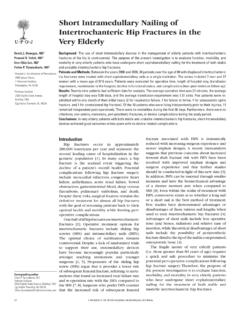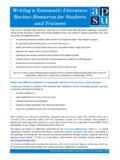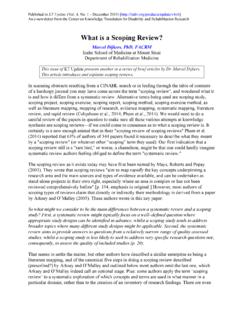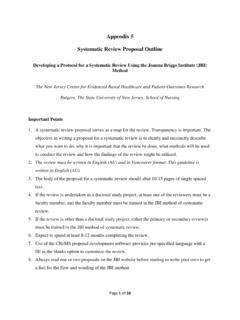Transcription of How to Write a Systematic Review: A Step-by-Step Guide
1 64 UNIVERSITY OF PENNSYLVANIA ORTHOPAEDIC JOURNAL How to Write a Systematic review : A Step-by-Step GuideIntroductionA Systematic review attempts to comprehensively and reproducibly collect, appraise, and synthesize all available empirical evidence that meets pre-defined criteria in order to answer a research question. The quantitative combination and statistical synthesis of the systematically-collected data is what defines a meta-analysis. Here, we first attempt to delineate the basic steps for conducting a Systematic review : initial planning, conducting the search, data extraction, and quality analysis. We then outline the fundamental steps for assessing the appropriateness of meta-analytic technique for your review and an explanation of statistical tools available for data analysis and presentation. An academic discussion regarding the strengths and weaknesses of Systematic review methodology is beyond the scope of this Guide , as are detailed instructions regarding statistical PlanningWhen initiating a Systematic review , it is important to plan ahead and anticipate problems.
2 By maintaining a clear study focus from the beginning, identifying a well-defined research question, outlining strict inclusion and exclusion criteria, and understanding the eventual contribution of your work to the existing literature , you can effectively minimize reviewer bias and streamline the review a Research QuestionAn appropriate, focused research question is based on an extensive a priori literature review to understand the scope of evidence available on your topic. It is often helpful to Write down your question first, then to conduct a literature review to determine whether your question has already been answered, can be answered, or is irrelevant and would pose an insignificant contribution. The PICO mnemonic (Population, Intervention, Comparison, Outcome) is a commonly used tool to help delineate a clearly defined, clinically-based question for your Systematic review .
3 In detail, the mnemonic refers to the following:1. Population: Define your subject group. Think about the age, sex, race and other patient characteristics, as well as relevant co-morbidities, pathology, and Intervention: Consider the prognostic factor or exposure (includes intervention) of Comparison: Repeat steps 1 and 2 for the group to whom you will compare your initially defined population and intervention (note: this step does not apply to all questions).4. Outcome: The item you hope to accomplish, measure, or define. For example: 1. P: Are adults with open fractures2. I: who undergo operative irrigation and debridement3. C: after a delay of greater than six hours from the time of injury at an 4. O: increased risk of developing osteomyeli-tis, soft tissue infection, and fracture non-union?
4 In the process of outlining a study question, it is clear that many critical terms within the question stem will need to be defined and characterized further. It is important that these terms are evaluated and discussed amongst your collaborators at the initial stages of the project, so as to eliminate potential confusion moving forward. For instance, in the above question, terms that require strict definitions are age (include pediatric patients?), open fractures (gunshot injuries excluded? only long bones?), osteomyelitis (culture-positive patients only?), soft tissue infection (those treated with antibiotics? or those who required an additional surgery?), and non-union (how long from initial injury?). With your question and these terms in mind, the future identification of relevant and appropriate literature will be JustificationAn initial literature review is required so that you can justify the significance of your work.
5 Your study may intend to do one or more of the following: 1) clarify strengths or weaknesses of existing literature ; 2) summarize large amounts of literature ; 3) resolve conflicts; 4) evaluate the need for a large clinical trial; 5) increase the statistical power of smaller studies; Corresponding author: Keith D. Baldwin, MD, MSPT, MPH Children s Hospital of Philadelphia Assistant Professor of Orthopaedic Surgery University of Pennsylvania 34th Street and Civic Center Boulevard Philadelphia, PA 19104 M. Yannascoli, MD1 Mara L. Schenker, MD1 James L. Carey, MD, MPH1 Jaimo Ahn, MD, PhD1,2 Keith D. Baldwin MD, MSPT, MPH1 Department of Orthopaedic Surgery, University of Pennsylvania, Philadelphia, PA2 Division of Orthopaedic Surgery, Children s Hospital of Philadelphia, Philadelphia, PA HOW TO Write A Systematic review : A Step-by-Step Guide 65 VOLUmE 23, JUNE 2013or 6) improve study generalizability.
6 Bear in mind that the purpose of a Systematic review is to not only collect all the relevant literature in an unbiased fashion, but to extract data presented in these articles in order to provide readers with a succinct synthesis of available evidence. As a general Guide , you should easily find on a broad non- Systematic search numerous papers that are relevant but may be excluded. Look carefully to see if your work has been previously published. If the most recent review is more than a few years old and the topic remains relevant, your contribution may still be of value. Finally, check the PROSPERO site ( ) to see if others are working to answer the same questions. If not, consider registering your SearchTo execute a well-designed study there are two requirements: 1) an organized team including a statistician, an expert in the field, and at least two individuals to oversee each section of the review process; and 2) a detailed study protocol.
7 For the latter, consideration will need to be given to specific search terms, inclusion and exclusion criteria, databases to be searched, and eventual data which will need to be collected and reported. Finally, persons experienced in conducting a search, a medical librarian, or both may offer guidance as you Search TermsSelecting the appropriate terminology is what guides the entire search, and thus is of crucial importance. Consider alternate terms, historical terminology, and even common misspellings. List these terms in the protocol before starting the search. Each search term (or terms) will need to be queried in each database that is used. A detailed search may be produced with the assistance of an experienced librarian who can customize a search in order to limit the number of extraneous hits. In cases with extremely specific questions this may be appropriate.
8 Additionally, the librarian may be able to assist you in obtaining rare journal articles or texts which may constitute part of your review . It is important to obtain the services of someone with expertise in Systematic reviews to minimize the prospect of bias infused by terms which are too and Exclusion CriteriaStrict criteria are necessary to determine the appropriate articles for inclusion. Some of these criteria will depend on your specific question ( exclude gunshot injuries as a mechanism of open fracture). General criteria applicable to any Systematic review are: level of evidence, language, and animal or human subjects. First, choose the level of evidence included for your particular study. This will depend on the existing literature and the overarching aim of your research. For topics that are well-represented in the literature with the aim to synthesize available evidence, it is common to include articles with high levels of evidence only (Levels I and II).
9 For topics that are less well-characterized with the aim to justify a larger clinical trial, inclusion of all levels of evidence may be warranted. It is important to remember that the quality of a Systematic review is defined by the lowest quality of the included studies. Next, decide whether the resources are available to include articles published in other languages. The inclusion of English-language articles only will certainly introduce bias, but is often necessary when resources are not available for information sources will need to be searched to perform a comprehensive Systematic review . medline includes articles published since 1966 and is freely available via Pubmed. EmBASE includes articles published since 1974 and requires a personal or university subscription to access. Surprisingly, there is only a 34% overlap of journals included in these two Therefore, using a single database alone is insufficient, with reports that only 30 to 80% of randomized controlled trials will be identified with medline database search Additionally, the Cochrane Controlled Trials Register does not overlap with the previous two databases and will need to be individually searched.
10 If you are conducting a review that is related to medical education, quality control, bioengineering, etc., there are a number of additional databases for alternate fields including education-focused, nursing, or engineering literature that may require the use of additional resources. A further search of the grey literature may produce additional references. For example, sites like may prove fruitful, especially if the topic is unusual or if a large publication bias is found. Keep in mind that medline and EmBASE articles are more likely to be well vetted, but also more vulnerable to publication OrganizationA key aspect to conducting and writing a Systematic review is reporting your exact methods for data collection. The most recent guidelines on conducting and reporting Systematic reviews are the PRISmA statement (Preferred Reporting Items for Systematic reviews and meta Analyses).











